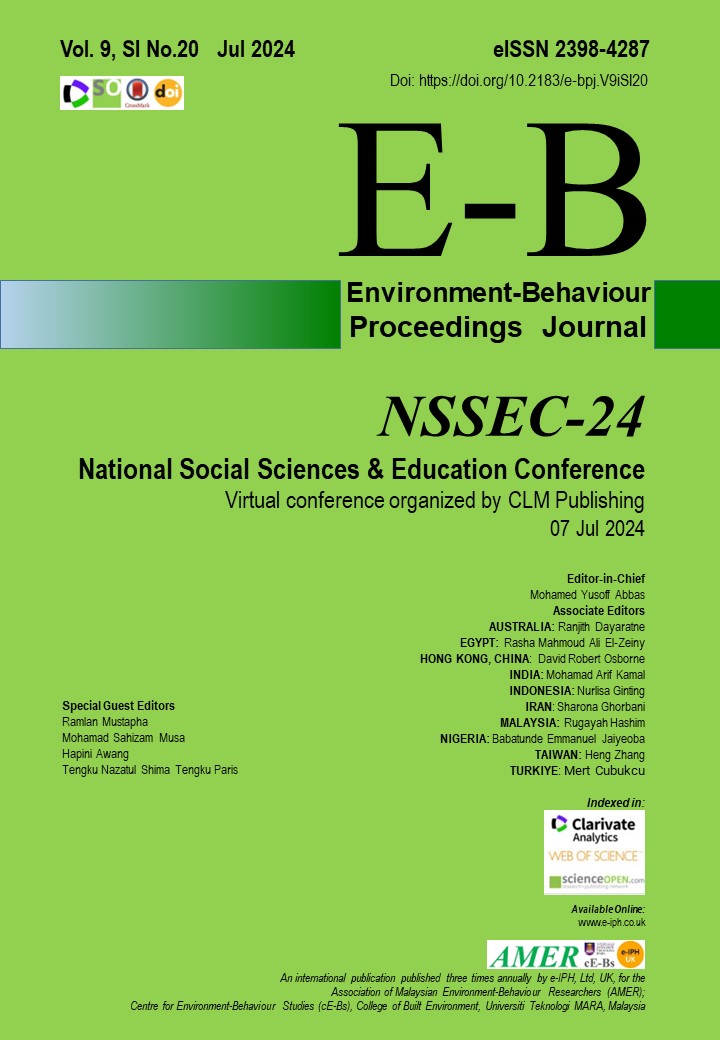Nexus between Climate Change, Technological Inputs, Energy Consumption and Cereal Production in India: An ARDL approach
DOI:
https://doi.org/10.21834/e-bpj.v9iSI20.6085Keywords:
ARDL, Cereal Production, Climate Change, India, Toda-Yamamoto Granger CausalityAbstract
Agriculture is vital to India's economy and food security but is highly vulnerable to climate change. This study examines the impact of rainfall, temperature, arable land, energy consumption, fertilizer, and technology inputs on cereal production in India from 1965 to 2018 using ARDL and Toda-Yamamoto Granger Causality techniques. Results show temperature negatively affects cereal production, while rainfall, arable land, energy, fertilizer, and technology have a positive impact. There is a unidirectional causal relationship between these factors and cereal production. The study suggests adopting modern technology, prioritizing organic farming, educating farmers, investing in agricultural R&D, and developing sustainable irrigation infrastructure.
References
Abidin, I. S. Z., Haseeb, M., Islam, R., & Chiat, L. W. (2022). Role of Technology Adoption, Labor Force and Capital Formation on the Rice Production in Malaysia. AgBioForum, 24(1), 41–49.
Amsden, Alice H. (1989). Asia's Next Giant: South Korea and Late Industrialization. Oxford: Oxford University Press.
Bayer, C., Hanck, C. (2013), Combining non‐cointegration tests. Journal of Time Series Analysis, 34(1), 83-95. DOI: https://doi.org/10.1111/j.1467-9892.2012.00814.x
Chandio, A. A., Akram, W., Ahmad, F., & Ahmad, M. (2020a). Dynamic relationship among agriculture-energy-forestry and carbon dioxide (CO2) emissions: empirical evidence from China. Environmental Science and Pollution Research, 27(27), 34078–34089. DOI: https://doi.org/10.1007/s11356-020-09560-z
Chandio, A. A., Jiang, Y., Amin, A., Akram, W., Ozturk, I., Sinha, A., & Ahmad, F. (2022b). Modeling the impact of climatic and non-climatic factors on cereal production: evidence from Indian agricultural sector. Environmental Science and Pollution Research, 29(10), 14634–14653. DOI: https://doi.org/10.1007/s11356-021-16751-9
Chandio, A. A., Gokmenoglu, K. K., Ahmad, M., & Jiang, Y. (2021c). Towards sustainable rice production in Asia: The role of climatic factors. Earth Systems and Environment, 1-14. DOI: https://doi.org/10.1007/s41748-021-00210-z
Chopra, R. R. (2022). Sustainability assessment of crops’ production in India: empirical evidence from ARDL-ECM approach. Journal of Agribusiness in Developing and Emerging Economies, ahead-of-p(ahead-of-print). DOI: https://doi.org/10.1108/JADEE-06-2021-0153
Datta, P., Behera, B., & Rahut, D. B. (2022). Climate change and Indian agriculture: A systematic review of farmers’ perception, adaptation, and transformation. Environmental Challenges, 8(May), 100543. DOI: https://doi.org/10.1016/j.envc.2022.100543
Firdaus, R. B. R., Leong Tan, M., Rahmat, S. R., & Senevi Gunaratne, M. (2020). Paddy, rice and food security in Malaysia: A review of climate change impacts. Cogent Social Sciences, 6(1). DOI: https://doi.org/10.1080/23311886.2020.1818373
Gul, A., Chandio, A. A., Siyal, S. A., Rehman, A., & Xiumin, W. (2022). How climate change is impacting the major yield crops of Pakistan? an exploration from long- and short-run estimation. Environmental Science and Pollution Research, 29(18), 26660–26674. DOI: https://doi.org/10.1007/s11356-021-17579-z
Guntukula, R. (2020). Assessing the impact of climate change on Indian agriculture: Evidence from major crop yields. Journal of Public Affairs, 20(1), e2040. DOI: https://doi.org/10.1002/pa.2040
Guntukula, R., & Goyari, P. (2020). Climate Change Effects on the Crop Yield and Its Variability in Telangana, India. Studies in Microeconomics, 8(1), 119–148. DOI: https://doi.org/10.1177/2321022220923197
Jena, P. K. (2021). Nexus between Climate Change and Agricultural Production in Odisha, India: An ARDL Approach. Int. J. Environ. Agric. Biotechnol, 6, 136-144. DOI: https://doi.org/10.22161/ijeab.62.15
Khan, T., Qiu, J., Banjar, A., Alharbey, R., Alzahrani, A. O., & Mehmood, R. (2021). Effect of climate change on fruit by co-integration and machine learning. International Journal of Climate Change Strategies and Management, 13(2), 208–226. DOI: https://doi.org/10.1108/IJCCSM-09-2020-0097
Kumar, P., Sahu, N. C., Ansari, M. A., & Kumar, S. (2021). Climate change and rice production in India: role of ecological and carbon footprint. Journal of Agribusiness in Developing and Emerging Economies. DOI: https://doi.org/10.1108/JADEE-06-2021-0152
Kumar, P., Sahu, N. C., Kumar, S., & Ansari, M. A. (2021b). Impact of climate change on cereal production: evidence from lower-middle-income countries. Environmental Science and Pollution Research, 28(37), 51597–51611. DOI: https://doi.org/10.1007/s11356-021-14373-9
Liew, V. K. S. (2004). Which lag length selection criteria should we employ?. Economics bulletin, 3(33), 1-9.
Mughal, M., & Fontan Sers, C. (2020). Cereal production, undernourishment, and food insecurity in South Asia. Review of Development Economics, 24(2), 524-545. DOI: https://doi.org/10.1111/rode.12659
Narayan, P. K. (2005). The saving and investment nexus for China: Evidence from cointegration tests. Applied Economics, 37(17), 1979–1990. DOI: https://doi.org/10.1080/00036840500278103
Pesaran et al., 2001 Bounds testing approaches to the analysis of level relationships, J. Appl. Econometr., 16 (3) (2001), pp. 289-326, DOI: https://doi.org/10.1002/jae.616
PIB (2023) India’s foodgrains production touched a record 315.7 million tonnes in 2021-22 https://www.pib.gov.in/PressReleseDetail.aspx?PRID=1894899, access on 13/2/2023
Ridzuan, N. H. A. M., Marwan, N. F., Khalid, N., Ali, M. H., & Tseng, M. L. (2020). Effects of agriculture, renewable energy, and economic growth on carbon dioxide emissions: Evidence of the environmental Kuznets curve. Resources, Conservation and Recycling, 160, 104879. DOI: https://doi.org/10.1016/j.resconrec.2020.104879
Škare, M., & Porada-Rochoń, M. (2023). Are we making progress on decarbonization? A panel heterogeneous study of the long-run relationship in selected economies. Technological Forecasting and Social Change, 188 (November 2022). DOI: https://doi.org/10.1016/j.techfore.2022.122279
Soullier, G., Demont, M., Arouna, A., Lançon, F., & Mendez del Villar, P. (2020). The state of rice value chain upgrading in West Africa. Global Food Security, 25(February), 100365. DOI: https://doi.org/10.1016/j.gfs.2020.100365
Suri, S. and Sharma, N (2022), Climate Change Poses The Biggest Risk to Food Security in India, retrived 27 February 2023 from https://www.preventionweb.net/news/climate-change-poses-biggest-risk-food-security-india
Toda, H.Y., Yamamoto, T. (1995), Statistical inference in vector autoregressive with possibly integrated processes. Journal of Econometrics, 66(1), 255-250. DOI: https://doi.org/10.1016/0304-4076(94)01616-8
Warsame, A. A., Sheik-Ali, I. A., Barre, G. M., & Ahmed, A. (2022). Examining the effects of climate change and political instability on maize production in Somalia. Environmental Science and Pollution Research. https://doi.org/10.1007/s11356-022-22227-1 DOI: https://doi.org/10.21203/rs.3.rs-709389/v1
Downloads
Published
How to Cite
Issue
Section
License
Copyright (c) 2024 Nur Fakhzan Marwan, Mohd Faizal Azrul Azwan Che Harun, Asmidar Alias, Ratha Krishnan Suppiah

This work is licensed under a Creative Commons Attribution-NonCommercial-NoDerivatives 4.0 International License.





